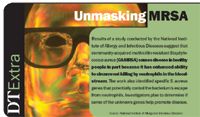- General Dermatology
- Eczema
- Chronic Hand Eczema
- Alopecia
- Aesthetics
- Vitiligo
- COVID-19
- Actinic Keratosis
- Precision Medicine and Biologics
- Rare Disease
- Wound Care
- Rosacea
- Psoriasis
- Psoriatic Arthritis
- Atopic Dermatitis
- Melasma
- NP and PA
- Skin Cancer
- Hidradenitis Suppurativa
- Drug Watch
- Pigmentary Disorders
- Acne
- Pediatric Dermatology
- Practice Management
- Prurigo Nodularis
Article
MRSA challenges dermatologists
Danville, Pa. — When a patient presents with a spontaneous abscess with surrounding cellulitis, physicians should suspect methicillin-resistant Staphylococcus aureus (MRSA), according to Dirk M. Elston, M.D.

Dr. Elston practices in the department of dermatology, Geisinger Medical Center, here.
"A spontaneous abscess in a young person, especially one involved in sports, strongly suggests MRSA," Dr. Elston tells Dermatology Times. MRSA incidence is much higher in people in close physical contact with one another, especially members of sports teams who have abrasions and share common equipment, for instance, wrestlers who share mats.
MRSA exists in two forms: healthcare-associated (HA) and community-acquired (CA).
"CA-MRSA is not just HA-MRSA that went home from the hospital with someone," Dr. Elston says. The two forms are genetically different organisms. HA-MRSA has a longer history, tends to be resistant to multiple antibiotics, and has a much larger resistance gene cassette than CA-MRSA. The type IV gene cassette of CA-MRSA is small and only codes for CA-MRSA. New strains of multi-drug resistant CA-MRSA have been identified in Asia and may spread to U.S. shores, Dr. Elston adds.
CA-MRSA is more virulent than methicillin-stable S. aureus (MSSA) and colonies are more likely to progress to clinical infection, Dr. Elston explains. CA-MRSA has caused severe or fatal pneumonitis, especially in children, and those patients may also experience bone or joint infections. CA-MRSA may also cause very serious skin and soft tissue infections including necrotizing fasciitis. Fortunately, most skin infections present as abscess and respond to drainage.
CA-MRSA initially was reported in Los Angeles among homosexuals, prison inmates and members of sports teams, Dr. Elston says.
"Since then, it's popped up in widely disseminated foci all over the United States, Europe and Asia."
Dr. Elston says risk factors for HA-MRSA include:
Risk factors for CA-MRSA include:
Treatment of MRSA
Dr. Elston says MRSA abscesses may respond to drainage alone, as do other abscesses.
"Any collection of purulent material must be drained. With MSRA, as with other staphylococcal abscesses, drainage is the single most important aspect of treatment, and antibiotic therapy is secondary," he says, and notes that this was demonstrated by Fridkin and colleagues (N Engl J Med. 2005;352:1436-1444) and discussed in an editorial by Chambers (N Engl J Med. 2005;352:1485-1487).
Outcomes data reported by Fridkin show that patients who had incision and drainage did well, even when they received an antibiotic to which the organism was resistant.





